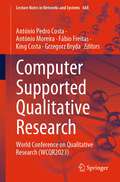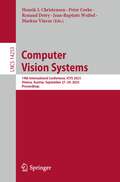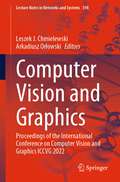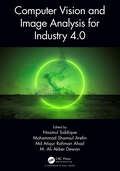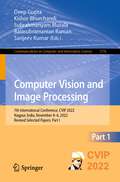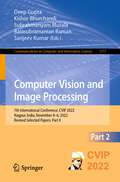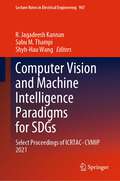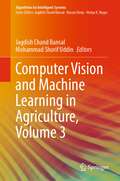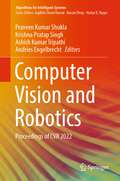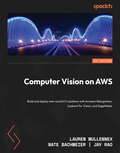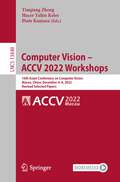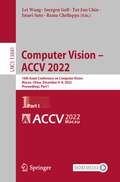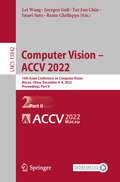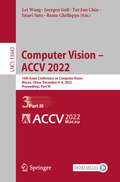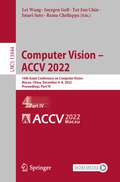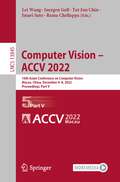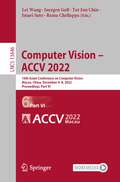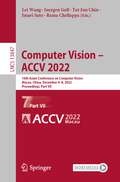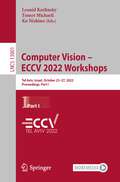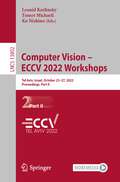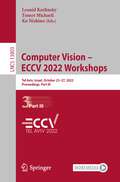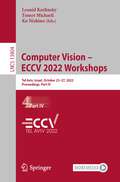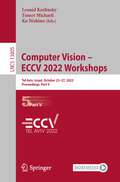- Table View
- List View
Computer Supported Qualitative Research: World Conference on Qualitative Research (WCQR2023) (Lecture Notes in Networks and Systems #688)
by António Moreira António Pedro Costa Grzegorz Bryda Fábio Freitas King CostaThis book includes selecting the articles accepted for presentation and discussion at WCQR2023, held from January 25 to 27, 2023 (face to face and virtual conference). The World Conference on Qualitative Research (WCQR) is an annual event that aims to bring together researchers, academics and professionals, promoting the sharing and discussing knowledge, new perspectives, experiences and innovations in qualitative research. WCQR2023 featured four main application fields (education, health, social sciences and engineering/technology) and seven main subjects: rationale and paradigms of qualitative research; systematization of approaches with qualitative studies; qualitative and mixed methods research; data analysis types; innovative processes of qualitative data analysis; qualitative research in web context; and qualitative analysis with software support. The book is valuable for everyone interested in qualitative research, emphasizing Computer-Assisted Qualitative Data Analysis Software (CAQDAS).
Computer Vision Systems: 14th International Conference, ICVS 2023, Vienna, Austria, September 27–29, 2023, Proceedings (Lecture Notes in Computer Science #14253)
by Peter Corke Henrik I. Christensen Markus Vincze Renaud Detry Jean-Baptiste WeibelThis volume LNCS 14253 constitutes the refereed proceedings of the 14th International Conference, ICVS 2023, in Vienna, Austria, in September 2023.. The 37 full papers presented were carefully reviewed and selected from 74 submissions. The conference focuses on Humans and Hands; Medical and Health Care; Farming and Forestry; Automation and Manufacturing; Mobile Robotics and Autonomous Systems; and Performance and Robustness.
Computer Vision and Graphics: Proceedings of the International Conference on Computer Vision and Graphics ICCVG 2022 (Lecture Notes in Networks and Systems #598)
by Leszek J. Chmielewski Arkadiusz OrłowskiThis book contains 17 papers presented at the conference devoted to cutting-edge technologies and concepts related to image processing. A broad collection of problems including man–machine interfaces, comparison of quantum and conventional computing in deep learning, medical image processing, image segmentation, face recognition, outdoor scene analysis, image rendering and colorization, map generation, traffic analysis, hardware acceleration, data association, and visual cryptography is investigated.Research on these issues is important, among others due to that large amounts of video data are collected continually. They can be easily stored, but their analysis is still a challenge.The book is primarily intended for researchers and practitioners in image analysis and generation, as well as for students in the fields related to computer science. However, any reader interested in the subject matter of the book will find some chapters interesting and valuable.
Computer Vision and Image Analysis for Industry 4.0
by Nazmul Siddique Mohammad Shamsul Arefin Ahad, Md Atiqur Rahman Dewan, M. Ali AkberComputer vision and image analysis are indispensable components of every automated environment. Modern machine vision and image analysis techniques play key roles in automation and quality assurance. Working environments can be improved significantly if we integrate computer vision and image analysis techniques. The more advancement in innovation and research in computer vision and image processing, the greater the efficiency of machines as well as humans. Computer Vision and Image Analysis for Industry 4.0 focuses on the roles of computer vision and image analysis for 4.0 IR-related technologies. The text proposes a variety of techniques for disease detection and prediction, text recognition and signature verification, image captioning, flood level assessment, crops classifications and fabrication of smart eye-controlled wheelchairs.
Computer Vision and Image Processing: 7th International Conference, CVIP 2022, Nagpur, India, November 4–6, 2022, Revised Selected Papers, Part I (Communications in Computer and Information Science #1776)
by Sanjeev Kumar Balasubramanian Raman Subrahmanyam Murala Deep Gupta Kishor BhurchandiThis two volume set (CCIS 1776-1777) constitutes the refereed proceedings of the 7th International Conference on Computer Vision and Image Processing, CVIP 2022, held in Nagpur, India, November 4–6, 2022. The 110 full papers and 11 short papers were carefully reviewed and selected from 307 submissions. Out of 121 papers, 109 papers are included in this book. The topical scope of the two-volume set focuses on Medical Image Analysis, Image/ Video Processing for Autonomous Vehicles, Activity Detection/ Recognition, Human Computer Interaction, Segmentation and Shape Representation, Motion and Tracking, Image/ Video Scene Understanding, Image/Video Retrieval, Remote Sensing, Hyperspectral Image Processing, Face, Iris, Emotion, Sign Language and Gesture Recognition, etc.
Computer Vision and Image Processing: 7th International Conference, CVIP 2022, Nagpur, India, November 4–6, 2022, Revised Selected Papers, Part II (Communications in Computer and Information Science #1777)
by Sanjeev Kumar Balasubramanian Raman Subrahmanyam Murala Deep Gupta Kishor BhurchandiThis two volume set (CCIS 1776-1777) constitutes the refereed proceedings of the 7th International Conference on Computer Vision and Image Processing, CVIP 2022, held in Nagpur, India, November 4–6, 2022.The 110 full papers and 11 short papers were carefully reviewed and selected from 307 submissions. Out of 121 papers, 109 papers are included in this book. The topical scope of the two-volume set focuses on Medical Image Analysis, Image/ Video Processing for Autonomous Vehicles, Activity Detection/ Recognition, Human Computer Interaction, Segmentation and Shape Representation, Motion and Tracking, Image/ Video Scene Understanding, Image/Video Retrieval, Remote Sensing, Hyperspectral Image Processing, Face, Iris, Emotion, Sign Language and Gesture Recognition, etc.
Computer Vision and Machine Intelligence Paradigms for SDGs: Select Proceedings of ICRTAC-CVMIP 2021 (Lecture Notes in Electrical Engineering #967)
by Sabu M. Thampi Shyh-Hau Wang R. Jagadeesh KannanThis book constitutes refereed proceedings of the 4th International Conference on Recent Trends in Advanced Computing - Computer Vision and Machine Intelligence Paradigms for Sustainable Development Goals. This book covers novel and state-of-the-art methods in computer vision coupled with intelligent techniques including machine learning, deep learning, and soft computing techniques. The contents of this book will be useful to researchers from industry and academia. This book includes contemporary innovations, trends, and concerns in computer vision with recommended solutions to real-world problems adhering to sustainable development from researchers across industry and academia. This book serves as a valuable reference resource for academics and researchers across the globe.
Computer Vision and Machine Intelligence: Proceedings of CVMI 2022 (Lecture Notes in Networks and Systems #586)
by Xiaoyi Jiang Massimo Tistarelli Satish Kumar Singh Shiv Ram DubeyThis book presents selected research papers on current developments in the fields of computer vision and machine intelligence from International Conference on Computer Vision and Machine Intelligence (CVMI 2022). The book covers topics in image processing, artificial intelligence, machine learning, deep learning, computer vision, machine intelligence, etc. The book is useful for researchers, postgraduate and undergraduate students, and professionals working in this domain.
Computer Vision and Machine Learning in Agriculture, Volume 3 (Algorithms for Intelligent Systems)
by Jagdish Chand Bansal Mohammad Shorif UddinThis book is as an extension of the previous two volumes on “Computer Vision and Machine Learning in Agriculture”. This volume 3 discusses solutions to the problems of agricultural production by rendering advanced machine learning including deep learning tools and techniques. The book contains 13 chapters that focus on in-depth research outputs in precision agriculture, crop farming, horticulture, floriculture, vertical farming, animal husbandry, disease detection, plant recognition, production yield, product quality, defect assessment, and overall automation through robots and drones. The topics covered in the current volume, along with the previous volumes, are comprehensive literature for both beginners and experienced in this domain.
Computer Vision and Robotics: Proceedings of CVR 2022 (Algorithms for Intelligent Systems)
by Andries Engelbrecht Praveen Kumar Shukla Krishna Pratap Singh Ashish Kumar TripathiThis book is a collection of the high-quality research articles in the field of computer vision and robotics which are presented in International Conference on Computer Vision and Robotics (ICCVR 2022), organized by BBD University Lucknow India, during 21 – 22 May 2022. The book discusses applications of computer vision and robotics in the fields like medical science, defence and smart city planning. This book presents recent works from researchers, academicians, industry, and policy makers.
Computer Vision and Robotics: Proceedings of CVR 2023 (Algorithms for Intelligent Systems)
by Andries Engelbrecht Praveen Kumar Shukla Himanshu MittalThis book consists of a collection of the high-quality research articles in the field of computer vision and robotics which are presented in the International Conference on Computer Vision and Robotics (CVR 2023), organized by BBD University Lucknow, India, during 24–25 February 2023. The book discusses applications of computer vision and robotics in the fields like medical science, defence, and smart city planning. The book presents recent works from researchers, academicians, industry, and policy makers.
Computer Vision on AWS: Build and deploy real-world CV solutions with Amazon Rekognition, Lookout for Vision, and SageMaker
by Lauren Mullennex Nate Bachmeier Jay RaoDevelop scalable computer vision solutions for real-world business problems and discover scaling, cost reduction, security, and bias mitigation best practices with AWS AI/ML servicesPurchase of the print or Kindle book includes a free PDF eBookKey FeaturesLearn how to quickly deploy and automate end-to-end CV pipelines on AWSImplement design principles to mitigate bias and scale production of CV workloadsWork with code examples to master CV concepts using AWS AI/ML servicesBook DescriptionComputer vision (CV) is a field of artificial intelligence that helps transform visual data into actionable insights to solve a wide range of business challenges. This book provides prescriptive guidance to anyone looking to learn how to approach CV problems for quickly building and deploying production-ready models.You'll begin by exploring the applications of CV and the features of Amazon Rekognition and Amazon Lookout for Vision. The book will then walk you through real-world use cases such as identity verification, real-time video analysis, content moderation, and detecting manufacturing defects that'll enable you to understand how to implement AWS AI/ML services. As you make progress, you'll also use Amazon SageMaker for data annotation, training, and deploying CV models. In the concluding chapters, you'll work with practical code examples, and discover best practices and design principles for scaling, reducing cost, improving the security posture, and mitigating bias of CV workloads.By the end of this AWS book, you'll be able to accelerate your business outcomes by building and implementing CV into your production environments with the help of AWS AI/ML services.What you will learnApply CV across industries, including e-commerce, logistics, and mediaBuild custom image classifiers with Amazon Rekognition Custom LabelsCreate automated end-to-end CV workflows on AWSDetect product defects on edge devices using Amazon Lookout for VisionBuild, deploy, and monitor CV models using Amazon SageMakerDiscover best practices for designing and evaluating CV workloadsDevelop an AI governance strategy across the entire machine learning life cycleWho this book is forIf you are a machine learning engineer or data scientist looking to discover best practices and learn how to build comprehensive CV solutions on AWS, this book is for you. Knowledge of AWS basics is required to grasp the concepts covered in this book more effectively. A solid understanding of machine learning concepts and the Python programming language will also be beneficial.
Computer Vision – ACCV 2022 Workshops: 16th Asian Conference on Computer Vision, Macao, China, December 4–8, 2022, Revised Selected Papers (Lecture Notes in Computer Science #13848)
by Yinqiang Zheng Hacer Yalim Keleş Piotr KoniuszThis book constitutes the refereed post-conference proceedings of the workshops held at the 16th Asian Conference on Computer Vision, ACCV 2022, which took place in Macao, China, in December 2022. The 25 papers included in this book were carefully reviewed and selected from 40 submissions. They have been organized in topical sections as follows: Learning with limited data for face analysis; adversarial machine learning towards advanced vision systems; computer vision for medical computing; machine learning and computing for visual semantic analysis; vision transformers theory and applications; and deep learning-based small object detection from images and videos.
Computer Vision – ACCV 2022: 16th Asian Conference on Computer Vision, Macao, China, December 4–8, 2022, Proceedings, Part I (Lecture Notes in Computer Science #13841)
by Juergen Gall Rama Chellappa Lei Wang Imari Sato Tat-Jun ChinThe 7-volume set of LNCS 13841-13847 constitutes the proceedings of the 16th Asian Conference on Computer Vision, ACCV 2022, held in Macao, China, December 2022. The total of 277 contributions included in the proceedings set was carefully reviewed and selected from 836 submissions during two rounds of reviewing and improvement. The papers focus on the following topics: Part I: 3D computer vision; optimization methods; Part II: applications of computer vision, vision for X; computational photography, sensing, and display; Part III: low-level vision, image processing; Part IV: face and gesture; pose and action; video analysis and event recognition; vision and language; biometrics; Part V: recognition: feature detection, indexing, matching, and shape representation; datasets and performance analysis; Part VI: biomedical image analysis; deep learning for computer vision; Part VII: generative models for computer vision; segmentation and grouping; motion and tracking; document image analysis; big data, large scale methods.
Computer Vision – ACCV 2022: 16th Asian Conference on Computer Vision, Macao, China, December 4–8, 2022, Proceedings, Part II (Lecture Notes in Computer Science #13842)
by Juergen Gall Rama Chellappa Lei Wang Imari Sato Tat-Jun ChinThe 7-volume set of LNCS 13841-13847 constitutes the proceedings of the 16th Asian Conference on Computer Vision, ACCV 2022, held in Macao, China, December 2022. The total of 277 contributions included in the proceedings set was carefully reviewed and selected from 836 submissions during two rounds of reviewing and improvement. The papers focus on the following topics: Part I: 3D computer vision; optimization methods; Part II: applications of computer vision, vision for X; computational photography, sensing, and display; Part III: low-level vision, image processing; Part IV: face and gesture; pose and action; video analysis and event recognition; vision and language; biometrics; Part V: recognition: feature detection, indexing, matching, and shape representation; datasets and performance analysis; Part VI: biomedical image analysis; deep learning for computer vision; Part VII: generative models for computer vision; segmentation and grouping; motion and tracking; document image analysis; big data, large scale methods.
Computer Vision – ACCV 2022: 16th Asian Conference on Computer Vision, Macao, China, December 4–8, 2022, Proceedings, Part III (Lecture Notes in Computer Science #13843)
by Juergen Gall Rama Chellappa Lei Wang Imari Sato Tat-Jun ChinThe 7-volume set of LNCS 13841-13847 constitutes the proceedings of the 16th Asian Conference on Computer Vision, ACCV 2022, held in Macao, China, December 2022. The total of 277 contributions included in the proceedings set was carefully reviewed and selected from 836 submissions during two rounds of reviewing and improvement. The papers focus on the following topics: Part I: 3D computer vision; optimization methods; Part II: applications of computer vision, vision for X; computational photography, sensing, and display; Part III: low-level vision, image processing; Part IV: face and gesture; pose and action; video analysis and event recognition; vision and language; biometrics; Part V: recognition: feature detection, indexing, matching, and shape representation; datasets and performance analysis; Part VI: biomedical image analysis; deep learning for computer vision; Part VII: generative models for computer vision; segmentation and grouping; motion and tracking; document image analysis; big data, large scale methods.
Computer Vision – ACCV 2022: 16th Asian Conference on Computer Vision, Macao, China, December 4–8, 2022, Proceedings, Part IV (Lecture Notes in Computer Science #13844)
by Juergen Gall Rama Chellappa Lei Wang Imari Sato Tat-Jun ChinThe 7-volume set of LNCS 13841-13847 constitutes the proceedings of the 16th Asian Conference on Computer Vision, ACCV 2022, held in Macao, China, December 2022. The total of 277 contributions included in the proceedings set was carefully reviewed and selected from 836 submissions during two rounds of reviewing and improvement. The papers focus on the following topics: Part I: 3D computer vision; optimization methods; Part II: applications of computer vision, vision for X; computational photography, sensing, and display; Part III: low-level vision, image processing; Part IV: face and gesture; pose and action; video analysis and event recognition; vision and language; biometrics; Part V: recognition: feature detection, indexing, matching, and shape representation; datasets and performance analysis; Part VI: biomedical image analysis; deep learning for computer vision; Part VII: generative models for computer vision; segmentation and grouping; motion and tracking; document image analysis; big data, large scale methods.
Computer Vision – ACCV 2022: 16th Asian Conference on Computer Vision, Macao, China, December 4–8, 2022, Proceedings, Part V (Lecture Notes in Computer Science #13845)
by Juergen Gall Rama Chellappa Lei Wang Imari Sato Tat-Jun ChinThe 7-volume set of LNCS 13841-13847 constitutes the proceedings of the 16th Asian Conference on Computer Vision, ACCV 2022, held in Macao, China, December 2022. The total of 277 contributions included in the proceedings set was carefully reviewed and selected from 836 submissions during two rounds of reviewing and improvement. The papers focus on the following topics: Part I: 3D computer vision; optimization methods; Part II: applications of computer vision, vision for X; computational photography, sensing, and display; Part III: low-level vision, image processing; Part IV: face and gesture; pose and action; video analysis and event recognition; vision and language; biometrics; Part V: recognition: feature detection, indexing, matching, and shape representation; datasets and performance analysis; Part VI: biomedical image analysis; deep learning for computer vision; Part VII: generative models for computer vision; segmentation and grouping; motion and tracking; document image analysis; big data, large scale methods.
Computer Vision – ACCV 2022: 16th Asian Conference on Computer Vision, Macao, China, December 4–8, 2022, Proceedings, Part VI (Lecture Notes in Computer Science #13846)
by Juergen Gall Rama Chellappa Lei Wang Imari Sato Tat-Jun ChinThe 7-volume set of LNCS 13841-13847 constitutes the proceedings of the 16th Asian Conference on Computer Vision, ACCV 2022, held in Macao, China, December 2022. The total of 277 contributions included in the proceedings set was carefully reviewed and selected from 836 submissions during two rounds of reviewing and improvement. The papers focus on the following topics: Part I: 3D computer vision; optimization methods; Part II: applications of computer vision, vision for X; computational photography, sensing, and display; Part III: low-level vision, image processing; Part IV: face and gesture; pose and action; video analysis and event recognition; vision and language; biometrics; Part V: recognition: feature detection, indexing, matching, and shape representation; datasets and performance analysis; Part VI: biomedical image analysis; deep learning for computer vision; Part VII: generative models for computer vision; segmentation and grouping; motion and tracking; document image analysis; big data, large scale methods.
Computer Vision – ACCV 2022: 16th Asian Conference on Computer Vision, Macao, China, December 4–8, 2022, Proceedings, Part VII (Lecture Notes in Computer Science #13847)
by Juergen Gall Rama Chellappa Lei Wang Imari Sato Tat-Jun ChinThe 7-volume set of LNCS 13841-13847 constitutes the proceedings of the 16th Asian Conference on Computer Vision, ACCV 2022, held in Macao, China, December 2022. The total of 277 contributions included in the proceedings set was carefully reviewed and selected from 836 submissions during two rounds of reviewing and improvement. The papers focus on the following topics: Part I: 3D computer vision; optimization methods; Part II: applications of computer vision, vision for X; computational photography, sensing, and display; Part III: low-level vision, image processing; Part IV: face and gesture; pose and action; video analysis and event recognition; vision and language; biometrics; Part V: recognition: feature detection, indexing, matching, and shape representation; datasets and performance analysis; Part VI: biomedical image analysis; deep learning for computer vision; Part VII: generative models for computer vision; segmentation and grouping; motion and tracking; document image analysis; big data, large scale methods.
Computer Vision – ECCV 2022 Workshops: Tel Aviv, Israel, October 23–27, 2022, Proceedings, Part I (Lecture Notes in Computer Science #13801)
by Ko Nishino Leonid Karlinsky Tomer MichaeliThe 8-volume set, comprising the LNCS books 13801 until 13809, constitutes the refereed proceedings of 38 out of the 60 workshops held at the 17th European Conference on Computer Vision, ECCV 2022. The conference took place in Tel Aviv, Israel, during October 23-27, 2022; the workshops were held hybrid or online.The 367 full papers included in this volume set were carefully reviewed and selected for inclusion in the ECCV 2022 workshop proceedings. They were organized in individual parts as follows: Part I: W01 - AI for Space; W02 - Vision for Art; W03 - Adversarial Robustness in the Real World; W04 - Autonomous Vehicle Vision Part II: W05 - Learning With Limited and Imperfect Data; W06 - Advances in Image Manipulation; Part III: W07 - Medical Computer Vision; W08 - Computer Vision for Metaverse; W09 - Self-Supervised Learning: What Is Next?; Part IV: W10 - Self-Supervised Learning for Next-Generation Industry-Level Autonomous Driving; W11 - ISIC Skin Image Analysis; W12 - Cross-Modal Human-Robot Interaction; W13 - Text in Everything; W14 - BioImage Computing; W15 - Visual Object-Oriented Learning Meets Interaction: Discovery, Representations, and Applications; W16 - AI for Creative Video Editing and Understanding; W17 - Visual Inductive Priors for Data-Efficient Deep Learning; W18 - Mobile Intelligent Photography and Imaging; Part V: W19 - People Analysis: From Face, Body and Fashion to 3D Virtual Avatars; W20 - Safe Artificial Intelligence for Automated Driving; W21 - Real-World Surveillance: Applications and Challenges; W22 - Affective Behavior Analysis In-the-Wild; Part VI: W23 - Visual Perception for Navigation in Human Environments: The JackRabbot Human Body Pose Dataset and Benchmark; W24 - Distributed Smart Cameras; W25 - Causality in Vision; W26 - In-Vehicle Sensing and Monitorization; W27 - Assistive Computer Vision and Robotics; W28 - Computational Aspects of Deep Learning; Part VII: W29 - Computer Vision for Civil and Infrastructure Engineering; W30 - AI-Enabled Medical Image Analysis: Digital Pathology and Radiology/COVID19; W31 - Compositional and Multimodal Perception; Part VIII: W32 - Uncertainty Quantification for Computer Vision; W33 - Recovering 6D Object Pose; W34 - Drawings and Abstract Imagery: Representation and Analysis; W35 - Sign Language Understanding; W36 - A Challenge for Out-of-Distribution Generalization in Computer Vision; W37 - Vision With Biased or Scarce Data; W38 - Visual Object Tracking Challenge.
Computer Vision – ECCV 2022 Workshops: Tel Aviv, Israel, October 23–27, 2022, Proceedings, Part II (Lecture Notes in Computer Science #13802)
by Ko Nishino Leonid Karlinsky Tomer MichaeliThe 8-volume set, comprising the LNCS books 13801 until 13809, constitutes the refereed proceedings of 38 out of the 60 workshops held at the 17th European Conference on Computer Vision, ECCV 2022. The conference took place in Tel Aviv, Israel, during October 23-27, 2022; the workshops were held hybrid or online.The 367 full papers included in this volume set were carefully reviewed and selected for inclusion in the ECCV 2022 workshop proceedings. They were organized in individual parts as follows: Part I: W01 - AI for Space; W02 - Vision for Art; W03 - Adversarial Robustness in the Real World; W04 - Autonomous Vehicle Vision Part II: W05 - Learning With Limited and Imperfect Data; W06 - Advances in Image Manipulation; Part III: W07 - Medical Computer Vision; W08 - Computer Vision for Metaverse; W09 - Self-Supervised Learning: What Is Next?; Part IV: W10 - Self-Supervised Learning for Next-Generation Industry-Level Autonomous Driving; W11 - ISIC Skin Image Analysis; W12 - Cross-Modal Human-Robot Interaction; W13 - Text in Everything; W14 - BioImage Computing; W15 - Visual Object-Oriented Learning Meets Interaction: Discovery, Representations, and Applications; W16 - AI for Creative Video Editing and Understanding; W17 - Visual Inductive Priors for Data-Efficient Deep Learning; W18 - Mobile Intelligent Photography and Imaging; Part V: W19 - People Analysis: From Face, Body and Fashion to 3D Virtual Avatars; W20 - Safe Artificial Intelligence for Automated Driving; W21 - Real-World Surveillance: Applications and Challenges; W22 - Affective Behavior Analysis In-the-Wild; Part VI: W23 - Visual Perception for Navigation in Human Environments: The JackRabbot Human Body Pose Dataset and Benchmark; W24 - Distributed Smart Cameras; W25 - Causality in Vision; W26 - In-Vehicle Sensing and Monitorization; W27 - Assistive Computer Vision and Robotics; W28 - Computational Aspects of Deep Learning; Part VII: W29 - Computer Vision for Civil and Infrastructure Engineering; W30 - AI-Enabled Medical Image Analysis: Digital Pathology and Radiology/COVID19; W31 - Compositional and Multimodal Perception; Part VIII: W32 - Uncertainty Quantification for Computer Vision; W33 - Recovering 6D Object Pose; W34 - Drawings and Abstract Imagery: Representation and Analysis; W35 - Sign Language Understanding; W36 - A Challenge for Out-of-Distribution Generalization in Computer Vision; W37 - Vision With Biased or Scarce Data; W38 - Visual Object Tracking Challenge.
Computer Vision – ECCV 2022 Workshops: Tel Aviv, Israel, October 23–27, 2022, Proceedings, Part III (Lecture Notes in Computer Science #13803)
by Ko Nishino Leonid Karlinsky Tomer MichaeliThe 8-volume set, comprising the LNCS books 13801 until 13809, constitutes the refereed proceedings of 38 out of the 60 workshops held at the 17th European Conference on Computer Vision, ECCV 2022. The conference took place in Tel Aviv, Israel, during October 23-27, 2022; the workshops were held hybrid or online.The 367 full papers included in this volume set were carefully reviewed and selected for inclusion in the ECCV 2022 workshop proceedings. They were organized in individual parts as follows: Part I: W01 - AI for Space; W02 - Vision for Art; W03 - Adversarial Robustness in the Real World; W04 - Autonomous Vehicle Vision Part II: W05 - Learning With Limited and Imperfect Data; W06 - Advances in Image Manipulation; Part III: W07 - Medical Computer Vision; W08 - Computer Vision for Metaverse; W09 - Self-Supervised Learning: What Is Next?; Part IV: W10 - Self-Supervised Learning for Next-Generation Industry-Level Autonomous Driving; W11 - ISIC Skin Image Analysis; W12 - Cross-Modal Human-Robot Interaction; W13 - Text in Everything; W14 - BioImage Computing; W15 - Visual Object-Oriented Learning Meets Interaction: Discovery, Representations, and Applications; W16 - AI for Creative Video Editing and Understanding; W17 - Visual Inductive Priors for Data-Efficient Deep Learning; W18 - Mobile Intelligent Photography and Imaging; Part V: W19 - People Analysis: From Face, Body and Fashion to 3D Virtual Avatars; W20 - Safe Artificial Intelligence for Automated Driving; W21 - Real-World Surveillance: Applications and Challenges; W22 - Affective Behavior Analysis In-the-Wild; Part VI: W23 - Visual Perception for Navigation in Human Environments: The JackRabbot Human Body Pose Dataset and Benchmark; W24 - Distributed Smart Cameras; W25 - Causality in Vision; W26 - In-Vehicle Sensing and Monitorization; W27 - Assistive Computer Vision and Robotics; W28 - Computational Aspects of Deep Learning; Part VII: W29 - Computer Vision for Civil and Infrastructure Engineering; W30 - AI-Enabled Medical Image Analysis: Digital Pathology and Radiology/COVID19; W31 - Compositional and Multimodal Perception; Part VIII: W32 - Uncertainty Quantification for Computer Vision; W33 - Recovering 6D Object Pose; W34 - Drawings and Abstract Imagery: Representation and Analysis; W35 - Sign Language Understanding; W36 - A Challenge for Out-of-Distribution Generalization in Computer Vision; W37 - Vision With Biased or Scarce Data; W38 - Visual Object Tracking Challenge.
Computer Vision – ECCV 2022 Workshops: Tel Aviv, Israel, October 23–27, 2022, Proceedings, Part IV (Lecture Notes in Computer Science #13804)
by Ko Nishino Leonid Karlinsky Tomer MichaeliThe 8-volume set, comprising the LNCS books 13801 until 13809, constitutes the refereed proceedings of 38 out of the 60 workshops held at the 17th European Conference on Computer Vision, ECCV 2022. The conference took place in Tel Aviv, Israel, during October 23-27, 2022; the workshops were held hybrid or online.The 367 full papers included in this volume set were carefully reviewed and selected for inclusion in the ECCV 2022 workshop proceedings. They were organized in individual parts as follows: Part I: W01 - AI for Space; W02 - Vision for Art; W03 - Adversarial Robustness in the Real World; W04 - Autonomous Vehicle Vision Part II: W05 - Learning With Limited and Imperfect Data; W06 - Advances in Image Manipulation; Part III: W07 - Medical Computer Vision; W08 - Computer Vision for Metaverse; W09 - Self-Supervised Learning: What Is Next?; Part IV: W10 - Self-Supervised Learning for Next-Generation Industry-Level Autonomous Driving; W11 - ISIC Skin Image Analysis; W12 - Cross-Modal Human-Robot Interaction; W13 - Text in Everything; W14 - BioImage Computing; W15 - Visual Object-Oriented Learning Meets Interaction: Discovery, Representations, and Applications; W16 - AI for Creative Video Editing and Understanding; W17 - Visual Inductive Priors for Data-Efficient Deep Learning; W18 - Mobile Intelligent Photography and Imaging; Part V: W19 - People Analysis: From Face, Body and Fashion to 3D Virtual Avatars; W20 - Safe Artificial Intelligence for Automated Driving; W21 - Real-World Surveillance: Applications and Challenges; W22 - Affective Behavior Analysis In-the-Wild; Part VI: W23 - Visual Perception for Navigation in Human Environments: The JackRabbot Human Body Pose Dataset and Benchmark; W24 - Distributed Smart Cameras; W25 - Causality in Vision; W26 - In-Vehicle Sensing and Monitorization; W27 - Assistive Computer Vision and Robotics; W28 - Computational Aspects of Deep Learning; Part VII: W29 - Computer Vision for Civil and Infrastructure Engineering; W30 - AI-Enabled Medical Image Analysis: Digital Pathology and Radiology/COVID19; W31 - Compositional and Multimodal Perception; Part VIII: W32 - Uncertainty Quantification for Computer Vision; W33 - Recovering 6D Object Pose; W34 - Drawings and Abstract Imagery: Representation and Analysis; W35 - Sign Language Understanding; W36 - A Challenge for Out-of-Distribution Generalization in Computer Vision; W37 - Vision With Biased or Scarce Data; W38 - Visual Object Tracking Challenge.
Computer Vision – ECCV 2022 Workshops: Tel Aviv, Israel, October 23–27, 2022, Proceedings, Part V (Lecture Notes in Computer Science #13805)
by Ko Nishino Leonid Karlinsky Tomer MichaeliThe 8-volume set, comprising the LNCS books 13801 until 13809, constitutes the refereed proceedings of 38 out of the 60 workshops held at the 17th European Conference on Computer Vision, ECCV 2022. The conference took place in Tel Aviv, Israel, during October 23-27, 2022; the workshops were held hybrid or online.The 367 full papers included in this volume set were carefully reviewed and selected for inclusion in the ECCV 2022 workshop proceedings. They were organized in individual parts as follows: Part I: W01 - AI for Space; W02 - Vision for Art; W03 - Adversarial Robustness in the Real World; W04 - Autonomous Vehicle Vision Part II: W05 - Learning With Limited and Imperfect Data; W06 - Advances in Image Manipulation; Part III: W07 - Medical Computer Vision; W08 - Computer Vision for Metaverse; W09 - Self-Supervised Learning: What Is Next?; Part IV: W10 - Self-Supervised Learning for Next-Generation Industry-Level Autonomous Driving; W11 - ISIC Skin Image Analysis; W12 - Cross-Modal Human-Robot Interaction; W13 - Text in Everything; W14 - BioImage Computing; W15 - Visual Object-Oriented Learning Meets Interaction: Discovery, Representations, and Applications; W16 - AI for Creative Video Editing and Understanding; W17 - Visual Inductive Priors for Data-Efficient Deep Learning; W18 - Mobile Intelligent Photography and Imaging; Part V: W19 - People Analysis: From Face, Body and Fashion to 3D Virtual Avatars; W20 - Safe Artificial Intelligence for Automated Driving; W21 - Real-World Surveillance: Applications and Challenges; W22 - Affective Behavior Analysis In-the-Wild; Part VI: W23 - Visual Perception for Navigation in Human Environments: The JackRabbot Human Body Pose Dataset and Benchmark; W24 - Distributed Smart Cameras; W25 - Causality in Vision; W26 - In-Vehicle Sensing and Monitorization; W27 - Assistive Computer Vision and Robotics; W28 - Computational Aspects of Deep Learning; Part VII: W29 - Computer Vision for Civil and Infrastructure Engineering; W30 - AI-Enabled Medical Image Analysis: Digital Pathology and Radiology/COVID19; W31 - Compositional and Multimodal Perception; Part VIII: W32 - Uncertainty Quantification for Computer Vision; W33 - Recovering 6D Object Pose; W34 - Drawings and Abstract Imagery: Representation and Analysis; W35 - Sign Language Understanding; W36 - A Challenge for Out-of-Distribution Generalization in Computer Vision; W37 - Vision With Biased or Scarce Data; W38 - Visual Object Tracking Challenge.
